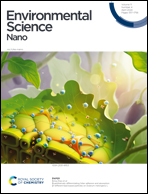Silver nanoparticle doped laser-induced graphene fabrication methodology affects silver nanoparticle size, distribution, biological and electrochemical properties†
Abstract
Laser-induced graphene (LIG) and its composites have been explored widely in many applications. Optimization of the LIG material usually requires variation of different lasing and environmental parameters, which can lead to diverse morphological and physicochemical properties. Heteroatom doping and metal-doped LIG have been investigated, although more understanding of the fabrication parameters is needed for obtaining controlled metal nanoparticle-graphene composites. Specifically, the tuning of nanoparticles within LIG is important because nanoparticle size and distribution can lead to different physicochemical, and electrochemical properties, and thus can affect the function of the material. Here we show a systematic comparison of three different preparation processes for silver doped LIG and the variable morphologies, size of nanoparticles, physicochemical, antibacterial, and electrochemical properties. Silver nitrate was coated on a poly(ether sulfone) (PES) substrate or an LIG substrate and lased, which was compared to a lased silver/chitosan colloidal solution on PES. Surface agglomerated, or homogeneous distributions or nanoparticles with average sizes ranging from ∼13–19 nm were observed. Raman analysis indicated that the graphene quality of the samples was similar to the LIG, except for direct lasing of AgNO3 on PES, which did not show a 2D peak at ∼2700 cm−1. However, each approach resulted in composites with antibacterial activity, although different electrochemical properties, such as electron transfer resistance (Ret) and double layer capacitance (Cdl) were observed. The lased silver/chitosan material showed minimum Ret of 20.3 Ω, with highest Cdl values of 71.6 μF. Our study highlights that the variation of fabrication methodology can highly impact metal nanoparticle size, distribution, and electrochemical properties throughout the LIG composite, which might be useful to design a suitable LIG material for various applications including electrocatalysis, electrochemical sensing, and many more.



 Please wait while we load your content...
Please wait while we load your content...